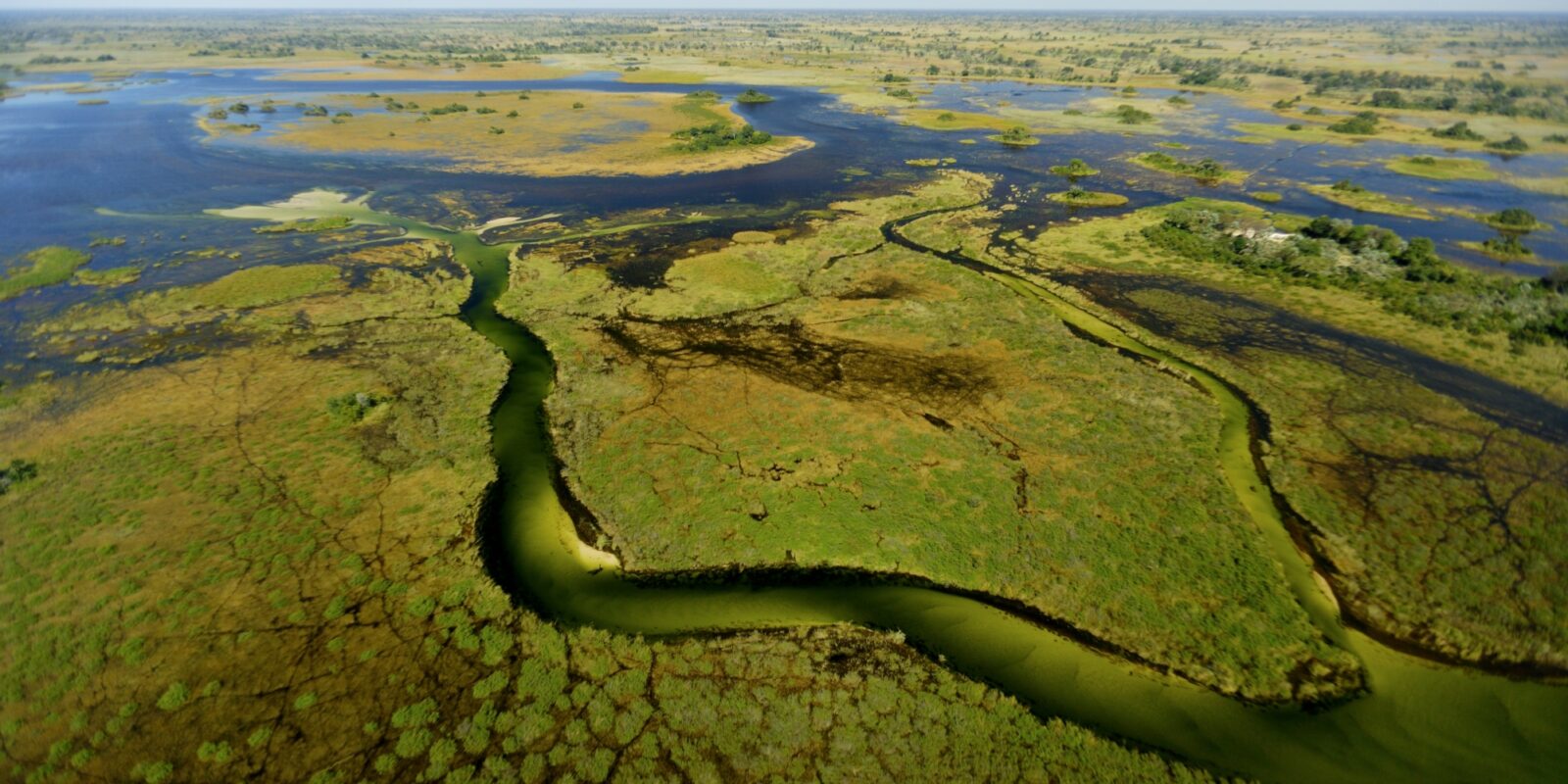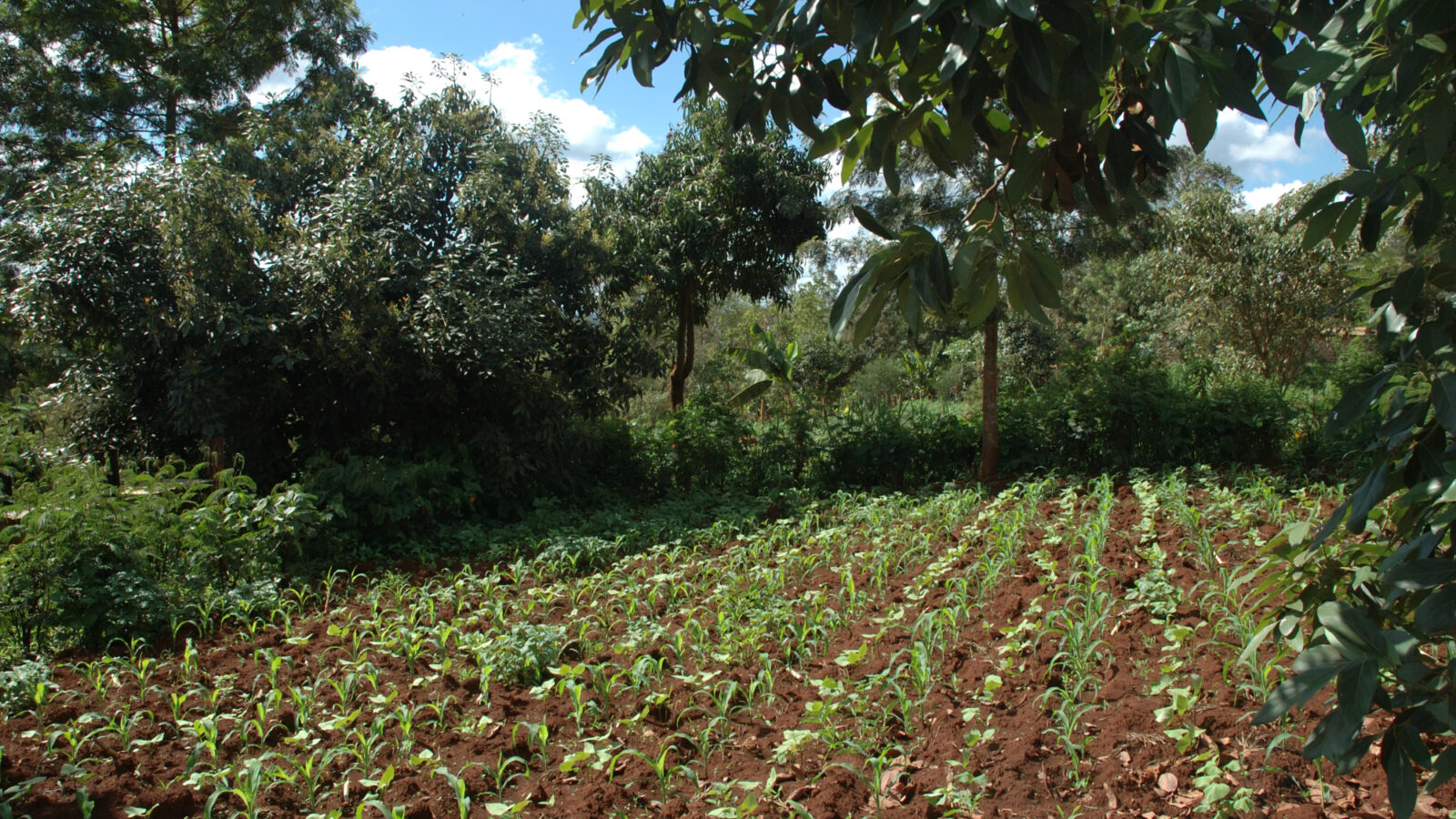Interventions: Natural Infrastructure
Natural infrastructure restoration and management can be a physically effective and cost-efficient way to enhance food production and deliver climate and nutrition security. Ana Yang outlines three imperatives necessary for achieving this.

The Okavango Delta, Botswana. Image: Marka/UIG via Getty Images.
Introduction
Natural infrastructure such as forests, wetlands and coastal and ocean habitats underpin the global food system and provide support for the livelihoods of millions of people. It provides critical ecosystem services including the provision of clean water and air, pollination, soil conservation, carbon sequestration and nutrient recycling. Natural infrastructure also acts as a critical defence against disasters, for example by providing flood protections, stabilizing soils and creating natural barriers to storm surges.
In cities, planned systems of natural infrastructure can provide clean water, regulate storm water runoff and cools and cleans air – for example living walls and roofs. Because of the similarities in these services, some have compared natural infrastructure to built infrastructure1. The role of natural infrastructure in tackling global climate change, in particular by providing carbon sinks through oceans, forests and soils, is also increasingly recognized.
Scientists have warned that the capacity of natural infrastructure to provide critical ecosystem and other services is being threatened. Land use change – primarily driven by agriculture – poses the single greatest threat. This is pertinent to human health as roughly one quarter of the global burden of disease can be attributed to environmental degradation2 with habitat destruction often having direct health consequences. For example, the burning of forests and peatland in Indonesia has increased respiratory problems through worsened air quality. It also threatens long-term food and nutrition security as agriculture depends upon the natural infrastructure it is currently degrading.
There are three imperatives to build and maintain natural infrastructure for climate and nutrition security. These are to:
1. Protect what is already there;
2. Restore what has been degraded;
3. Manage sustainably for production.
Protect
Protecting the existing natural infrastructure stock is fundamental and often makes most sense from a cost-benefit perspective. Protective actions include establishing protected areas, national parks and conservation areas. Crucial to these efforts are accompanying measures to monitor and enforce. This is in part a question of resourcing and governance, and new technologies such as remote sensing are rapidly changing the cost calculus. Many areas for protection have already been identified by various conservation organizations such as the World Wide Fund for Nature, Conservation International and the International Union for Conservation of Nature.
Restore
Restoration of degraded or abandoned areas can deliver multiple benefits and provides the means to build natural infrastructure and increase ecosystem service provisioning. Different types of restoration can be adopted depending on the level of degradation. In many cases, simple fencing to stop animal grazing will allow natural restoration. At the other end of the spectrum, soil compaction can entail high restoration costs. In between, there are numerous interventions, including agroforestry and agro-ecological practices, that can allow for restoration while diversifying income streams and food supply, increasing resilience, improving nutrition and enhancing biodiversity. Polyculture – as opposed to monoculture – of trees for wood products, nuts and fruits, and temporal intercropping of different tree species, can smooth cash flow with earlier maturing crops generating earlier financial return.

Kenya's World Agroforestry Centre improves the livelihoods of poor farm shareholders and improves the sustainability and productivity of agricultural landscapes. Image: Wendy Stone/Corbis via Getty Images.
Fishery and coastal restoration supports the diversity and health of fish stocks. Greenhouse gas emissions from fisheries can be greatly reduced by sound management that allows fish stocks to recover and stabilize at healthy levels, making fish easier to catch using less fuel.
Coastal restoration is also important for flood and storm defences particularly in the context of rising sea levels and increasing storm intensity. For example, restored coastal natural infrastructure in the northeast of the United States prevented more than $625 million in property damages during Superstorm Sandy.3
Manage
Integrated land-management approaches balance competing claims on natural infrastructure and can overcome silos. This includes land use planning to allocate protection and production areas and cross-sectoral policy planning and economic zoning to manage natural infrastructure. Under this approach, protection and production needs are balanced and management approaches ensure mutual enhancement between the two. For example, set aside and riparian forests protect rivers thus ensuring better soil fertility while reducing soil erosion – a win for farmers who can adopt conservation agriculture and micro-dosing of fertilizers to reduce river pollution. Most importantly, these approaches can yield improved economic returns.
In terms of sustainable forest management, evidence of the benefits of tree polyculture is mounting.4 It can increase resilience and reduce the need for pest management and control. It can also ensure higher survival rates for the primary species and provide diversified income sources from different wood products. Sustainably managed mixed-species plantation forests can provide wood products to meet increasing demand for fibre, alleviating the pressure on natural forests. These techniques will become increasingly important in the context of the bioeconomy. Demand for wood products is projected to be double the available supply by 2030.5 Wood will be needed for new applications that displace fossil fuel-intensive materials while locking in carbon. Examples include cross-laminated timber6 – a highly engineered wood product for construction – and nanocellulose7 – produced by mixing wood pulp with algae – for super flexible screens and bio-plastic.
There is a strong correlation between soil fertility and soil carbon,8 so agro-ecological farming practices that enhance and maintain the latter, which can easily be lost with a return to poor practices, offer an opportunity to restore and manage soils while improving yields. The real challenge is around scaling up these efforts across diverse farming systems and agro-ecological zones.
Different scales for managing natural infrastructure
Integrated land management should be applied consistently at different scales: from the farm level to the landscape and jurisdictional level. At farm levels, restoration and management of natural infrastructure can increase productivity, enhance resilience and diversify food production, supporting improved nutrition. Beyond the farm, multifunctional landscape level planning is important to help cluster smaller pieces of natural habitat and create ecological corridors that maximize ecosystem services. Similarly watershed-level planning ensures the integrity of the water system and its replenishment capability.
Land use planning also needs to be multi-jurisdictional, encompassing local and national governments and authorities as well as ensuring the inclusion of urban planning. The below set of examples show the opportunities for integrated land use planning and urban planning to be cohesive, as natural infrastructure can occur at various scales in urban and rural contexts.
Examples of multi-jurisdictional urban planning
- Building: Green roofs, gardens, indoor plants, courtyard
- Street: Park ways, vegetated swales, vegetated permeable surfaces
- Community: Neighbourhood garden, neighbourhood parks, riparian buffers, botanical gardens, urban and peri-urban farms
- Region: Riparian system, metropolitan green belt, national parks and reserves
- Global: International ecological reserves
Source: Beatley (2000)
Combining natural and built infrastructure restoration and management can create win-win situations. For example, restoring marine vegetated habitat can be combined with cement-based solutions to protect the coastline from sea-level rise. Programmes, such as Trees for Cities, that promote the greening of urban areas through installations such as green roofing, can help combat heat waves, for example in Barcelona, and improved urban planning can also help to manage surface-water flows, for example in Vitoria-Gasteiz in Spain. Public-sector policy directives, such as the EU Green Infrastructure Strategy,9 can ensure appropriate consideration of natural infrastructure as part of a holistic strategy to secure services and benefits typically provided by built infrastructure.
However, these approaches imply engaging a wider audience beyond the environmental sector. Policymakers must be engaged across government and at different administrative levels. New evidence and planning approaches must also be brought to bear.
Finally, good governance is critical. This entails the inclusion of all stakeholders in the negotiation process as well as high levels of coordination between the various agencies, departments and authorities, regular monitoring and reviewing of goals and objectives to enable adaptive management, monitoring and enforcement of protected areas, and implementation of regulation to protect ecosystems from pollution and overexploitation.
Connecting consumers to producers
Better protection, restoration and management of natural infrastructure is easier to achieve when consumers demand it. Such market incentives can be complementary to command-and-control policies delivered by government. These approaches can be industry-led. The Tropical Forest Alliance, the Sustainable Fisheries Partnership’s 'Target 75' initiative and the Waste & Resources Action Programme (WRAP) efforts to reduce food waste and loss through promoting circular economy approaches are all examples of voluntary industry-led initiatives. Such approaches can be an important first step while governments catch-up with regulation to level the playing field.
New technologies and radical transparency are changing the game
Remote sensing, granular mapping tools and big data can be used to identify potential areas for restoration. Monitoring and enforcement is strengthened through high-frequency, high-granularity imaging of deforestation, land use change and fishing. Information can be tracked and transmitted across the supply-chain with blockchain technology, providing a new level of supply chain transparency and assurance, and creating new opportunities to link consumers and producers. These tools will help the financial sector stop funding businesses that are degrading natural infrastructure and civil society organizations will be able to hold governments and businesses to account.
New business models, project-valuation approaches and investment models are required
Natural infrastructure restoration and management can be a physically effective and cost-efficient way to enhance food production and deliver climate and nutrition security. However investors are more familiar with ‘brick and mortar’ built infrastructure, and are often poorly equipped to understand the full range of costs and benefits that accrue among multiple public and private actors. Business cases must consider different revenue streams, which may include carbon credits, water fees and other co-benefits such as fisheries and eco-tourism. Positive and negative environmental externalities need to be accounted for. The distribution of costs and benefits among public and private actors implies the need for public-private partnership approaches in many cases. At a minimum, there may be a role for public finance to reduce risk if investors unfamiliar with such projects are to be brought in.






